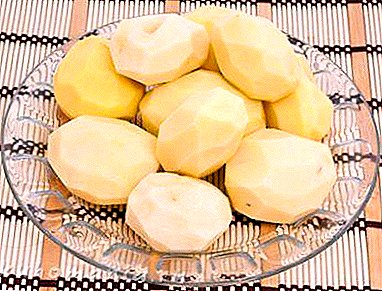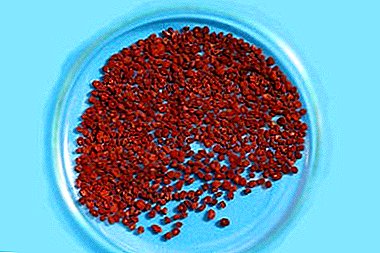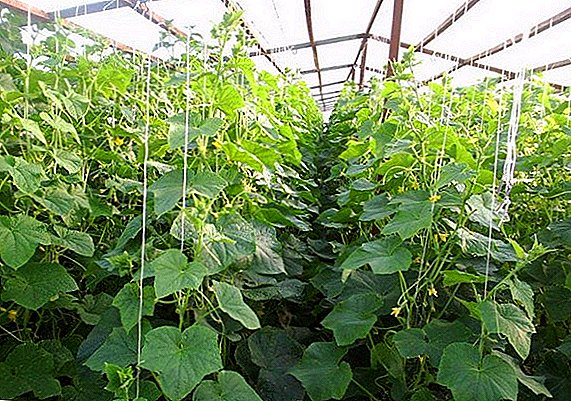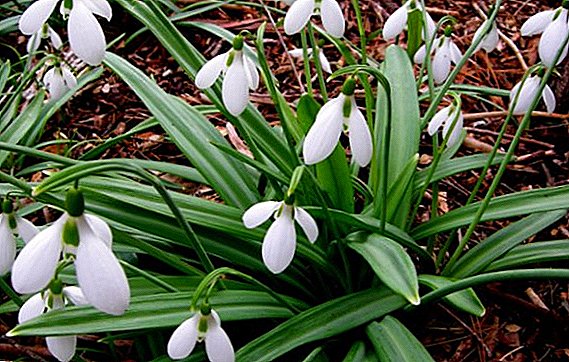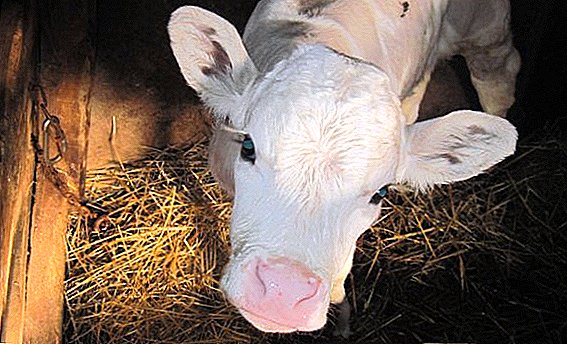 Bovine diarrhea (both adults and calves) is the main disease of non-infectious nature, from which young stock and adult herds can massively die, causing serious economic losses to the farm. For the occurrence of diarrhea, there are many reasons, it may not be an independent state, but only a symptom of a more serious illness. Today we will talk about how to identify the causes of the disorder, and what measures to take to prevent the massive loss of livestock.
Bovine diarrhea (both adults and calves) is the main disease of non-infectious nature, from which young stock and adult herds can massively die, causing serious economic losses to the farm. For the occurrence of diarrhea, there are many reasons, it may not be an independent state, but only a symptom of a more serious illness. Today we will talk about how to identify the causes of the disorder, and what measures to take to prevent the massive loss of livestock.
Causes
Accurate determination of the cause of diarrhea allows you to choose the most appropriate treatment strategy, as well as prevent cases of eating disorders in the future. Causes of non-infectious diarrhea are also called predisposing, as they do not cause diarrhea by themselves, but weaken the animal's body. 
These include:
- inaccuracies in the diet, food poisoning - the presence in the feed of mold, fungi, nitrates and metals, as well as useful food additives in an excessive amount (for example, salt);
- inadequate nutrition of the female during the period of gruiting the calf;
- lack of vitamins A, E and minerals;
- high humidity, low room temperature;
- failure to follow the feeding regime;
- water calves with cold milk.
Did you know? Nasolabial mirror of cows - akin to fingerprints and palms in humans. It has the same unique lines for each animal.Diarrhea can also be infectious:
- bacterial lesions (salmonella, E. coli E. coli, clostridia);
- viral lesions (coronavirus, rotavirus, infectious rhinotracheitis, ordinary diarrhea virus);
- protozoa (coccidia, cryptosporidia);
- yeast and mold lesions - they are very rarely the primary cause of diarrhea, but often accompanied by diseases of the stomach and intestines.

Main symptoms
Obviously, the main symptom of diarrhea are diluted fecal masses. Since they are very liquid and watery, with prolonged diarrhea, severe dehydration and washing out of all the beneficial elements occur, which is the most dangerous for a pet.
Did you know? With a night rest, a person also becomes dehydrated - during the period of sleep, we lose up to 0.5 liters of fluid.
The state of the animal with varying degrees of dehydration:
- water loss up to 4.5% - the animal can stand on its feet, there is depression, increased urination;
- water loss up to 8% - the animal can still stand on its feet, however, there are dead eyes, loss of skin elasticity, dry nose and mouth;
- water loss up to 10.5% - the above manifestations are exacerbated, the animal can not stand on its feet, there is a cold snap of the limbs and ears, at this stage, the animal can be saved by intravenous therapy;
- loss over 11-12% - with such a degree of dehydration, it is almost impossible to save the animal, since a shock and death occurs.

Clinical picture of viral diarrhea:
- If the causative agent is E. colithere are very abundant secretions. The disease has a fleeting nature, causes a general infection of the body, and without treatment ends fatally in almost 100% of cases. Usually infection with E. coli occurs in newborn calves at 2-7 days of life.
- When infected with rotavirus there is a profuse diarrhea - diarrhea practically does not stop, while the stools are very watery or consist entirely of water, are painted in a light yellow or whitish color, have a sour smell. Among other symptoms: the calf refuses to eat, becomes very weak and sluggish, there is a rise in temperature.
- If affected by coronavirus profuse diarrhea also occurs, but the feces have a greenish-yellow color, sometimes there are blood impurities. The temperature may be normal or low. With prolonged absence of treatment, ulcers may occur in the oral cavity, saliva turns into foam.
Learn how to feed the calves.
Diarrhea in calves: what to do, how and what to treat
If diarrhea occurs, you should immediately contact a veterinarian to establish the cause and take action as soon as possible, since dehydration can have fatal consequences, especially in young individuals. Diarrhea always requires treatment - this symptom almost never goes away on its own either in an adult herd, much less a young one.
Video: severe diarrhea in a weekly calf
General recommendations
First of all, before establishing the cause, it is necessary to create the most optimal conditions for the animal, because an already weakened organism can in no way be exposed to adverse environmental conditions:
- The patient must be isolated in a warm, dry, ventilated room with clean bedding disinfected for drinking water.
- Drink plenty of water to prevent severe dehydration. For watering, you can use a solution of glucose, calcium chloride.
- In no case should not allow hypothermia sick animal. To maintain the optimum temperature, you can use infrared or electric lamps.
Important! For the period of treatment of diarrhea to give the calf milk is strictly prohibited. Firstly, it is not absorbed in diarrhea, and secondly, milk is a very favorable environment for the development of pathological microorganisms that can aggravate the condition of a sick animal.
Medication
For food poisoning and diarrhea of infectious etiology, the following groups of drugs are prescribed for therapy:
- Regidratants. These funds are designed to stop excess fluid loss by the body, as well as restore electrolyte balance. You can use a solution of sodium chloride 0.9% subcutaneously, intramuscularly or intravenously, glucose solution 40%.
- Sorbents. Help reduce intoxication. Universal activated carbon is a universal and effective sorbent. For cows and calves can be used in this dosage: 1 tablet for every 10 kg of mass.
- Enzyme preparations. Contribute to the improvement of digestion. Usually used for animals that have converted to solid food, in the form of feed additives.
- Probiotics. They are used to eliminate dysbiosis and colonization of the intestine by friendly bacteria. You can use drugs Olin, Laktobifadol, Monosporin.
- Antibiotics. Regarding this group of drugs among veterinarians there are different opinions. Most agree that antibiotic therapy is needed only in severe cases. Tetracycline preparations are usually prescribed. For example, you can use regular tetracycline at a dosage of 2-3 tablets three times a day. Baytril 10% can be used for subcutaneous injections in a dosage of 2.5 mg per 1 kg of weight once a day for 5 days. You can also prick Tylosin intramuscularly at a dosage of 0.2-0.5 ml per 10 kg of weight once a day for 5 days.
 If the diarrhea is mild, the calf can be drank (if it can swallow itself), but if the animal is unable to stand and swallow due to the overly dried mucous mouth, it is necessary to use a special reservoir with a tube or administer liquid intravenously or via an IV. The use and dosage of drugs must be strictly coordinated with the doctor, since for animals of different ages and different states it may differ significantly.
If the diarrhea is mild, the calf can be drank (if it can swallow itself), but if the animal is unable to stand and swallow due to the overly dried mucous mouth, it is necessary to use a special reservoir with a tube or administer liquid intravenously or via an IV. The use and dosage of drugs must be strictly coordinated with the doctor, since for animals of different ages and different states it may differ significantly.Folk remedies
With a mild form of diarrhea, you can try to eliminate it with a simple folk remedy - cereal decoction. To do this, 150 g of grain (you can take rye, barley, oats) must be boiled for 1 hour in 1 liter of water, then cooled and filtered. This mixture should be given to the calf instead of milk 5 times during the day.
Important! If diarrhea does not disappear within 2-3 days, continue to apply folk recipes unreasonable and dangerous for the life of the animal!
In case of viral and bacterial diarrhea, it is necessary to take medication, but folk recipes can be used as an aid. Below we consider the most effective and simple recipes:
- Decoction of flax seeds. For cooking, it is necessary to boil 50 g of raw materials in a liter of water for an hour, then bring the amount to 2 liters with boiled water. Prepared means you need to give a sick animal to 0.5 liters in the morning and evening until the symptoms disappear.
- Broth hips and Hypericum. For cooking, you must use the hips and leaves with flowers of Hypericum in equal parts. 100 g of raw materials need to pour 1 liter of boiling water, infuse for 8 hours, drain. A sick individual should be given 250 ml three times a day until the symptoms disappear.
- Tea blend. From the ingredients you need: 1 tbsp. l salt, 3 raw chicken protein, 4 tsp. brewing black tea. It is necessary to make tea, pour in the specified amount of tea and a liter of boiling water, then add proteins and salt and mix thoroughly. During the month, give sick individuals once a day at the rate of: 10 g of the mixture per 1 kg of body weight.
- Beet juice based enema. This remedy is effective in any degree of severity of diarrhea, even with blood impurities. For the procedure, it is necessary every two hours, until the symptoms disappear, to put an enema from beet juice in the amount of 300-500 ml for small calves and up to 4 liters for adults.

Prevention
Significantly reduce the likelihood of diarrhea in calves and adult herds by adhering to the following recommendations:
- Strict and strict observance of all sanitary and hygienic standards of livestock. The premises must always be clean, dry, ventilated, warm.
- Timely vaccination of livestock to prevent the development of viral infection.
- As long as possible to give newborn calves colostrum, which is an ideal food in the first days and helps to form strong immunity.
- Newborn offspring should be separate from the entire herd (only with a cow). It is especially important to exclude the contact of the young with the feces of other individuals.
- It is necessary to strictly monitor the quality of all feed.
- You must comply with the feeding regime and daily routine.
- Small calves should not be given cold or stale (sour) milk, the optimum temperature is +38 ° C.
 Summing up, it can be said that diarrhea in cattle of all ages is a rather frequent, unpleasant and extremely dangerous phenomenon, which, in the absence of therapy, can lead to the loss of a large part of the livestock. The good news is that diarrhea can be eliminated if the cause is determined in time and adequate treatment is prescribed. However, it is much easier to prevent the development of diarrhea among the livestock - for this it is necessary to strictly adhere to all the rules and guidelines for caring for the young and adults.
Summing up, it can be said that diarrhea in cattle of all ages is a rather frequent, unpleasant and extremely dangerous phenomenon, which, in the absence of therapy, can lead to the loss of a large part of the livestock. The good news is that diarrhea can be eliminated if the cause is determined in time and adequate treatment is prescribed. However, it is much easier to prevent the development of diarrhea among the livestock - for this it is necessary to strictly adhere to all the rules and guidelines for caring for the young and adults.


